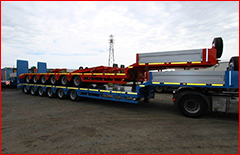A lowboy (low loader in British English, low-bed in western Canada and South Africa or float in Australia) is a semi-trailer with two drops in deck height: one right after the gooseneck and one right before the wheels. This allows the deck to be extremely low compared with other trailers. It offers the ability to carry legal loads up to 12 ft (3.66 m) tall, which other trailers cannot. Lowboys are used to haul heavy equipment such as bulldozers, industrial equipment etc.
The lowboy trailer comes in several types, for a wide range of tasks. Some types are:
- Fixed gooseneck (FGN): allows a longer deck length and has the lightest weight. These are lower trailers than normal, with low-profile tires, usually with drop ramps in the rear to facilitate loading of equipment, but are not actually considered “lowboys”. The neck is arched in such a way, that it when lowered, it becomes a ramp thus allowing the front tires of equipment to be pulled onto the deck.
- Fixed-neck: the neck is fixed to trailers; offers the lightest weight, but sacrifices the ability to detach and load over the front
- Hydraulic detachable gooseneck (hydraulic RGN or HRGN)): fastest and easiest to detach, at the expense of weight and deck length. It is the most common and versatile of lowboy trailers; the gooseneck is detached using large hydraulic cylinders to raise and lower the trailer and a small cylinder shores the neck to the truck, removing the neck so a large piece of equipment can be driven over the front onto the deck of the trailer for transport. The hydraulics can be run from the truck auxiliary or from a pony motor mounted in the neck of the trailer.
- Mechanically-detachable gooseneck (mechanical RGN or MRGN): while usually lighter than the hydraulic detachable gooseneck, users sacrifice ease and speed of detaching. Used for long specialty hauls.
- Mechanical folding gooseneck (MFGN): The deck folds down to ground level to provide a ramp for from trailer loading.










